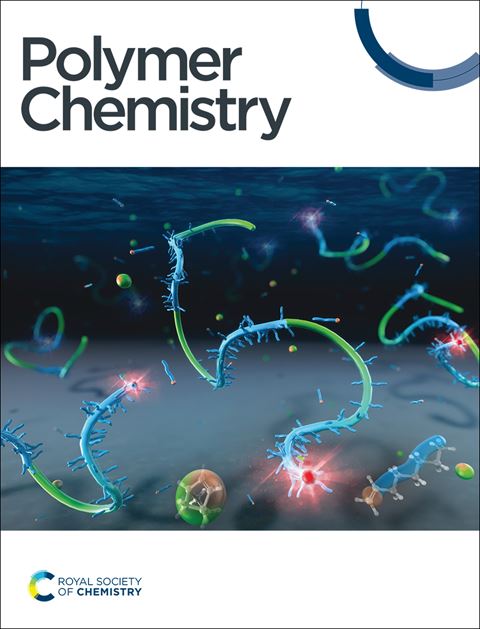区域选择性RAFT-HDA:一种精确拓扑控制超支化聚合物的新方法
IF 3.9
2区 化学
Q2 POLYMER SCIENCE
引用次数: 0
摘要
本研究提出了一种结合可逆加成-破碎链转移(RAFT)聚合和杂化- diols - alder (HDA)反应的新方法,以高效合成具有可控拓扑结构的超支化聚合物(HBPs)。传统的ABn单体制造HBPs的方法由于随机聚合和凝胶化的风险而面临局限性。通过将ABn体系优化为ABx大单体框架,这种新的RAFT-HDA方法实现了可控聚合,减少了分子内环化和拓扑缺陷,拓宽了可能的聚合物结构范围。此外,更容易获得和广泛使用的新型二烯和亲二烯化合物已被确定为HDA反应。通过合成具有不同分支度和分子量的各种HBPs,证明了该方法的通用性,这些HBPs通过NMR, FTIR, GPC和DLS技术进行了全面表征。该研究为合成复杂聚合物结构提供了一个强大而高效的途径,表明RAFT-HDA策略能够生产出定义良好的超支化聚合物,在纳米材料、生物医学和高级功能材料中具有巨大的应用潜力。本文章由计算机程序翻译,如有差异,请以英文原文为准。

Regioselective RAFT–HDA: a new approach to synthesize hyperbranched polymers with precise topology control†
This study introduces a novel approach combining reversible addition–fragmentation chain transfer (RAFT) polymerization and hetero-Diels–Alder (HDA) reactions to efficiently synthesize hyperbranched polymers (HBPs) with controlled topology. The traditional ABn monomer methods for creating HBPs face limitations due to random polymerization and the risk of gelation. By optimizing the ABn system into an ABx macromonomer framework, this new RAFT–HDA method enables controlled polymerization, reducing intramolecular cyclization and topological defects and broadening the range of possible polymer architectures. Additionally, more readily available and widely used novel dienes and dienophiles have been identified for the HDA reaction. The versatility of this approach was demonstrated by synthesizing a variety of HBPs with different branching degrees and molecular weights, which were thoroughly characterized by NMR, FTIR, GPC, and DLS techniques. This study provides a robust and efficient pathway for synthesizing complex polymer structures, demonstrating that the RAFT–HDA strategy enables the production of well-defined hyperbranched polymers with significant potential for applications in nanomaterials, biomedicine, and advanced functional materials.
求助全文
通过发布文献求助,成功后即可免费获取论文全文。
去求助
来源期刊

Polymer Chemistry
POLYMER SCIENCE-
CiteScore
8.60
自引率
8.70%
发文量
535
审稿时长
1.7 months
期刊介绍:
Polymer Chemistry welcomes submissions in all areas of polymer science that have a strong focus on macromolecular chemistry. Manuscripts may cover a broad range of fields, yet no direct application focus is required.
 求助内容:
求助内容: 应助结果提醒方式:
应助结果提醒方式:


